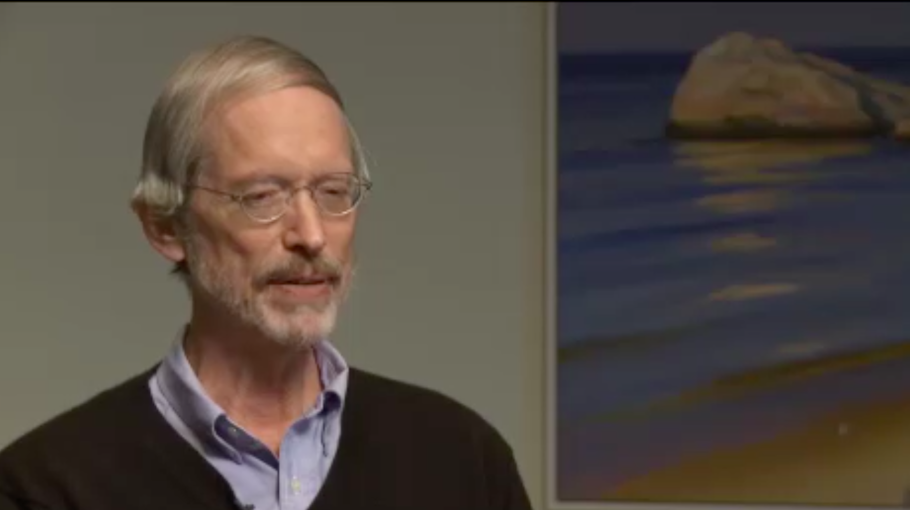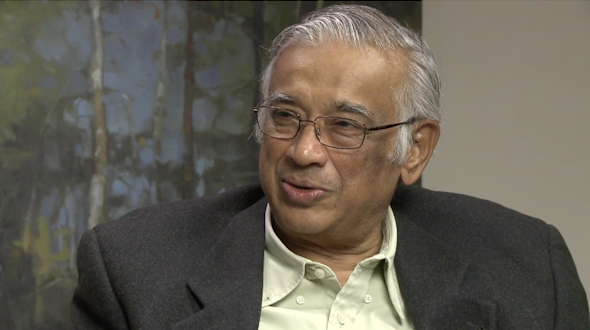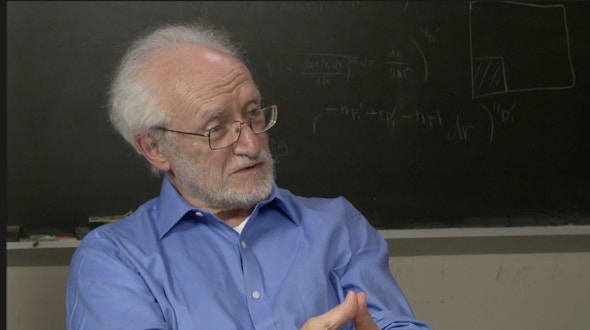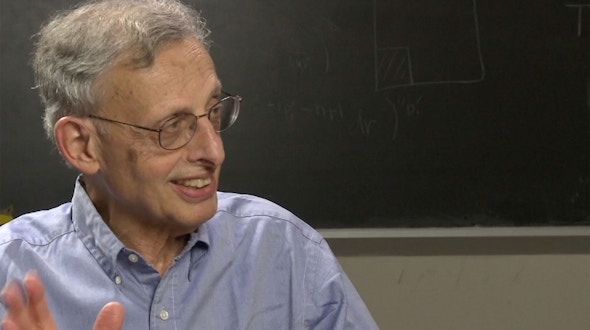Robert D. MacPherson
- Choosing mathematics (3:47)
- Frustrations with high school math (3:48)
- International differences in support of mathematical talent in high schools (2:27)
- Music and mathematics (3:45)
- Cultural differences in math and music (2:22)
- Graduate studies at Harvard (3:06)
- Learning from Raoul Bott (5:58)
- Why study singularities? (3:44)
- Raoul Bott and S.S. Chern (3:59)
- Intersection homology theory (5:26)
- Rene Thom, singularities, and catastrophe theory (4:45)
- Perverse sheaves (6:04)
- Singular Riemann-Roch Theorem (1:41)
- Mathematicians and playfulness (4:32)
- Pontryagin classes, Gelfand, first visit to Moscow (3:16)
- Independent University of Moscow (4:28)
- The culture of mathematics in Russia (9:01)
- Visiting Russia with money (3:15)
- Harvard, Brown, MIT, and IAS (3:12)
- Mentoring graduate students at IAS (4:13)
- Gays in science and technology (3:42)
- Growing up gay in the south (6:46)
- Awareness of being gay (8:41)
- Stuttering (5:00)
- Advice to graduate students (7:05)
- Working Habits (1:52)
- Unity of Mathematics (4:56)
- Future work (13:11)
- The magic of IAS (4:46)
If there is one thing that fascinates a mathematician, it’s a singularity. Singularities are places where the usual rules—of geometry, or algebra, or calculus, depending on the problem—break down. For instance, a black hole is a singularity in spacetime. A more ordinary example is the crossing point in a figure 8. If you were in a car driving along a figure-8 track, you could drive full speed ahead most of the time. Only at the crossing point would the rules change. It is the only place where traffic can come from another direction, and so you would have to slow down or stop and look both ways. That is the nature of singularities.

Robert MacPherson has made a career of going forward where other mathematicians were forced to stop. His specialty is understanding the structure of singularities in multi-dimensional spaces. Perhaps he is a singularity himself, in the best sense of the word. MacPherson is a person to whom the usual rules don’t apply.
The son of a conservative nuclear physicist, MacPherson became a political radical. He was beaten by police at a Vietnam War protest at Harvard. His first Ph.D. student, Mark Goresky, eventually became his life partner — an arrangement that was not unprecedented but was at least unusual in an era when it was harder for gays to “come out” publicly. “Goresky and MacPherson” has become practically a single mathematical entity, much like “Rogers and Hammerstein” or “Ben and Jerry.” In the early ’90s, MacPherson spearheaded a unique relief mission, raising more than $100,000 to keep Russian mathematics afloat and smuggling a significant part of that money into Russia himself.
MacPherson is not a rule-breaker by choice. He’s more of a rule-inventor, and nowhere is that more evident than in his mathematics. In the 1970s he and Goresky created a new theory called intersection homology, which has revolutionized the way that mathematicians deal with singularities. Previously, mathematicians had mostly worked around singularities. A black hole can be understood by looking at the space around it. A figure 8 can be understood—sort of—by looking at similar shapes: the hourglass shape formed by the outside edges of the track, or the two separate oblongs formed by the inside edges. Goresky and MacPherson’s rules have in many cases eliminated the need for such roundabout methods.
“Intersection homology totally changed the landscape,” says Paul Gunnells, a former student of MacPherson now at the University of Massachusetts at Amherst. “It’s a tool that is almost universally used now. For example, it revolutionized representation theory—it’s absolutely inconceivable nowadays that you could do without it.”
Math or Music?
Born in Ohio in 1944, MacPherson was the son of nuclear engineer Herbert MacPherson. Known as “Mac,” the elder MacPherson worked on the Manhattan Project as an expert in the production of graphite with no boron impurities. He was not too pleased that his son went into mathematics. “Among his friends, the word ‘mathematician’ was a put-down,” MacPherson says. “It meant a person who had no physical intuition, who was interested in the wrong aspects of any question and had no interest in reality.” However, MacPherson is about as far as possible from the stereotype of the unworldly mathematician. He is an avid cyclist, loves boats, and is an excellent chef and amateur carpenter. “He makes it a point to do everything at least once—build a wall, install plumbing, put up a barn,” says his former student Tom Braden, who now works at the University of Massachusetts at Amherst.
During his college years, mathematics faced some very stiff competition from another passion—music. MacPherson majored in both. “I studied the Well-Tempered Clavier and the Goldberg Variations more than I have studied any other book, including math books,” he says. “The density of ideas is incredible.”
Although his career led to mathematics, MacPherson remains a very serious musical enthusiast, an opera lover with front-row season tickets at the Metropolitan Opera in New York. “Bob is extremely allergic to background music,” says Goresky. “If there is music playing, then he’s listening to it, thinking about the harmonies, trying to hear the inner voices, concentrating on it.” The two own a Steinway grand piano, which MacPherson frequently plays after dinner.
On a summer internship at Oak Ridge, where his father was the deputy director, MacPherson worked with a mathematician named Robert Coveyou. They were a good match, neither really fitting into the buttoned-down culture of the national laboratory; Coveyou’s group was jokingly called the “Baker Street Irregulars.” But their work is still cited to this day.
To simulate nuclear reactions, engineers needed a way to generate lots of random numbers (because radioactive decay is inherently a random process). Mathematicians have devised various formulas to produce “pseudo-random” numbers. But Coveyou and MacPherson discovered that many of these approaches actually perform very badly. If you graph strings of two (or three, or twenty) consecutive pseudo-random numbers in a 2- (or 3-, or 20-) dimensional space, you will often find that they cluster onto planes instead of dispersing themselves randomly through space. Coveyou and MacPherson developed a “spectral test” to detect these bad pseudo-random number generators, a test that is still state-of-the-art today.
“Inventing Our Own World”

While he was in college, MacPherson says, he knew that he was somehow different. “I remember thinking that there was some difficulty, and this was a difficulty I was going to overcome. I didn’t have a name for it,” MacPherson says. The words “homosexual” or “gay” were never uttered back then—even as insults.
For a while, MacPherson seemed to have his “difficulty” licked. He got married as a graduate student at Harvard, and many friends considered it an ideal marriage. But in 1970 he took a teaching position at Brown, and in the fall of 1971 a graduate student named Mark Goresky arrived. Goresky was also married, but that didn’t stop a remarkable chemistry from emerging between the two men.
“During my third year of graduate school, Bob and I saw a lot of each other,” Goresky says. They worked together, had dinners together, planned a garden together. MacPherson invited Goresky and his wife to come with him to Paris the following year. “It is easy to see now, thirty years later, that the intensity and electricity that was developing in our relationship was something very unusual,” says Goresky. “But at the time, neither of us imagined that we might some day divorce our wives and move in together.”
Certainly what they had was far from a typical student-teacher relationship. One memorable day, they were working together on a problem and couldn’t agree on the notation. MacPherson decided that there was only one way to resolve the impasse: a duel with water pistols. They chased each other around the Brown math department, which was in an old house with lots of nooks, crannies and staircases, until finally MacPherson found the perfect spot to lay an ambush. Sure enough, he heard steps coming downstairs, leaped out and soaked… one of the most senior faculty members of the Brown mathematics department.
During their year in Paris, Goresky and MacPherson discovered intersection homology, the theory that would make both of them famous. Goresky picked up his doctorate in 1976, and they spent the next year apart. “During that year, both of us independently began to wonder about sexual orientation, and began to experiment to see what we were really attracted to,” recalls MacPherson. The following year, they spent ever more time with each other, hiking and working on intersection homology.
Still, it couldn’t last. In 1978, Goresky and his wife returned to Vancouver, their hometown, where he got a job at the University of British Columbia. To Goresky, it was like being banished to the mathematical hinterlands. After three years, he couldn’t take it any more, and moved back to Massachusetts. In theory, at least, that was what precipitated the breaking up of his marriage in 1981. By complete coincidence, MacPherson was separating from his wife at the same time, and the two couples got divorced in the same month. “On the other hand, it’s obviously not a coincidence,” MacPherson says. “You could see what was going on at an emotional level.”
In 1985, during a sabbatical in Rome, Goresky and MacPherson tried living together for the first time—an arrangement that was conveniently ambiguous as long as they were abroad. By 1987, the ambiguity was over. Both of them went on the job market, and made it clear they were a package deal. After MacPherson was offered a job at M.I.T. and Goresky received a substantial raise at Northeastern, they bought a hundred-year-old Victorian house in Quincy, Massachusetts, a commitment akin to a marriage. “I loved that house,” says Goresky. “I can still remember our first night there. It was a hot August evening and we had all the windows open. I fell asleep to the swoosh, swoosh of the waves on the shore.”
Asked to compare their story with Brokeback Mountain, MacPherson and Goresky give intriguingly different answers. “I guess the similarity is that both of us were highly resistant to the idea that we were gay, and we didn’t know any other gay people,” says MacPherson. “We were inventing our own world—that’s the parallel I would make withBrokeback Mountain.” For Goresky, the movie portrayed a fate narrowly averted. “I found the story quite moving,” he says. “Time and again, Ennis makes plans for them to move in together, but it never happens. Then Ennis dies, and Jack ends up living an empty life of memories and regrets. This almost happened to us. It was almost our story. I came very close to staying in Vancouver.”
Nowadays the two are much more connected to the gay community, but they are not sure how much it accepts them. One year MacPherson helped plan a session on careers at a symposium for gay people at his alma mater, Swarthmore College. He was stunned when no scientists were invited. The idea that gays could have careers in science was, apparently, news to the gay community. “I get that same impression when looking at the national gay media as well,” MacPherson says. “There is huge coverage of people in politics, in queer studies, artists and musicians. It’s almost as if, if you’re a creative gay, that’s the end of the story.”
And yet Goresky and MacPherson are far from the first. They are following in the footsteps of two of the most famous Russian mathematicians of the twentieth century. Andrei Kolmogorov (1903-1987) was virtually the inventor of probability theory, while Pavel Aleksandrov (1896-1982) was a topologist and inventor of “Aleksandrov spaces.” Though printed references to their relationship are extremely oblique—homosexuality was a crime in the Soviet Union—they lived together for more than half a century, and the nature of their friendship was an open secret in the closely knit circles of Soviet science.
“Every mathematician knew it, and there was a rumor that even Stalin himself knew it,” says MacPherson. “Kolmogorov was a member of the Academy of Sciences”—a body of great power in the USSR, quite unlike its American counterpart—”and he proposed Aleksandrov for membership. [Another mathematician, Nikolai] Luzin said, ‘In the academy we only have mathematicians, not wives of mathematicians.’ At this point, Kolmogorov got up and slapped Luzin,” MacPherson says.
But that wasn’t the end of the story. Word of the incident reached Stalin, the supreme dictator, who could easily arrange for anyone in the Soviet Union to disappear forever. Stalin pondered, sucked on his pipe, and then pronounced, “I sometimes lose my temper, too.” In this way Aleksandrov became a full member of the academy.
A Russian Winter
MacPherson has been closely connected to Russian mathematics since 1977, when he met Israel Gelfand, a student of Kolmogorov, in Paris. He first visited Moscow for several months in 1980, and returned yearly thereafter. He smuggled Russian research papers out for publication in Western journals, cutting the names of the authors off the papers so they would not be in danger if the papers were confiscated. Not that they ever were. Though it was illegal (the papers were supposed to be scrutinized first for “state secrets”), the border guards shrugged when they saw that it was “just mathematics.”
MacPherson, the consummate collaborator, found in Moscow the mathematical community of his dreams. “Every time I went there I would feel so happy, as if I had come home again,” he says. None of the leading mathematicians could get jobs doing math, because they were Jewish. Instead, they did research purely for the joy of it. “No one had an office, so math was done in people’s houses, over tea. The math was at such a high level, and so pure in its motivations,” MacPherson says. “People thought that never in their lifetime would they get any material reward for the work they did.”
Unfortunately, after the Soviet Union collapsed in 1991, the situation took a drastic turn for the worse. An economic crisis devalued the ruble to the point where $50 in American currency could support a family for a month. Russia’s mathematicians (and other academics, too), who had supported themselves with low-paying sinecure jobs, suddenly stopped getting any paychecks at all. “The government had a choice of paying them or the subway drivers, and they paid the subway drivers,” MacPherson says.
MacPherson begged the American Mathematical Society (AMS) to set up a relief fund, and within months, it received more than $100,000 in contributions from American mathematicians. “I’ve never heard of anything else like it,” Macpherson says. (Later, he helped persuade the Soros Foundation to contribute an even larger sum.)
But there was a problem: How could they get the money into the anarchic country? “This was the one romantic moment in my life,” MacPherson says. After the AMS determined that it was not worth paying outrageous commissions to untrustworthy middlemen, MacPherson and AMS staffer Tim Goggins decided to carry it by hand. “I was really worried,” says MacPherson, “because we were carrying about $23,000, and at that time you could be murdered for $50. The Russian law was that if we brought that kind of money in, we had to declare it at the border, but everyone knew the border guards were in touch with the hoodlums.” So after years of smuggling math papers out, he smuggled the money in.
MacPherson handed it out, $200 or $300 at a time, at Public School Number 2 in Moscow. He resists any suggestion that the money was largesse. Officially the payments were grants, awarded over the space of two years to 374 mathematicians on the basis of peer-reviewed applications. According to Sergei Gelfand, Israel Gelfand’s son (now an officer of the AMS), it was a watershed moment in Russian mathematical history—the first time that money had ever been awarded on the basis of merit. In spite of the chaotic conditions, every designated grantee eventually received his or her money, and every penny was accounted for. Most importantly, the program kept Russian mathematics going. “The situation today is definitely much better than I ever thought it would be,” says Gelfand.
Even so, MacPherson misses the old days. Most of his friends have now emigrated to the West, and to see them he now has to travel all over the world, instead of crowding into an apartment or a public school in Moscow. But he agrees that the Russian system is producing talented young mathematicians, and the rabid anti-Semitism is thankfully a thing of the past.
Partner and Teacher
It’s hard to tell exactly what has made Goresky and MacPherson such a perfect match, both as collaborators and as a couple. Part of it, undoubtedly, is that they are not clones of each other. Everyone who knows them comments on this: MacPherson is the geometric mind, the intuitive thinker whose lectures, more often than not, consist of drawing beautiful multi-colored pictures on the blackboard. Goresky is the perfectionist who makes sure all the details are correct, puts them into words, makes sure the papers get written. There is no “senior” or “junior” in the partnership, although it placed a strain on Goresky when MacPherson moved to his current position at the Institute for Advanced Studies in Princeton. Goresky had to swallow the pill of becoming an unpaid member of the institute, but he has gradually come to appreciate the role of an independent scholar.

Despite his Russian adventures, MacPherson’s influence on mathematics has mostly been quiet. He is widely praised as an expositor. “When someone gives a lecture at the Institute and [Pierre] Deligne or [Robert] Langlands is in the audience, the speaker feels the need to go as fast as possible,” says Braden. “Bob’s presence does not do that. Because of his personality, he inspires people to give talks that others will understand.” As an advisor, his quirks are legendary. Gunnells once wrote a guide for MacPherson students, which dispenses such advice as this: “If he leaves the room suddenly without announcement, don’t do anything. Just wait; most likely he’ll be back. Indeed, sometimes he will leave in the middle of a sentence, then return ten minutes later to complete the sentence as if nothing happened…. Exception: if he doesn’t return after half an hour or so, then you have missed the last train to Braintree.” Nevertheless, MacPherson does give his students a full hearing, on issues that can range far beyond math. “I spent my early graduate career being unsuccessfully mentored by straight white guys living conventional straight-white-guy lives,” says Laura Anderson, a professor at Binghamton University. “If any of them had any doubts about who they were and where they fit in the world, they didn’t show it. As I was preparing to bail out of math, I finally met Bob and had the first sympathetic conversation of my graduate career. He took a great weight of alienation off my shoulders.”
|
||
| Publications | List from homepage – Publication list from MacPherson’s Homepage (pdf download)MathSciNet – Password requiredHomepage – Institute for Advanced Study | |
| Press & Interviews, etc. | Measuring Shape with Homology, April 7, 2010 – IAS Video LecturesAutomorphic Forms – Geometry and the fundamental lemma, April 6, 2001 | |



